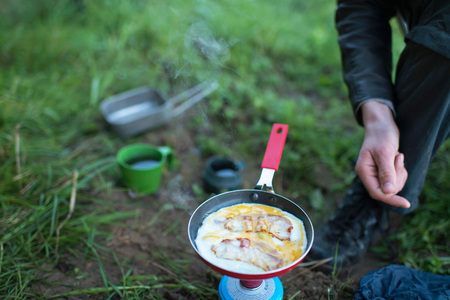1. Recognizing Common Wildlife in U.S. Campgrounds
When youre out camping in the great outdoors, its important to know what kind of wild animals you might come across. Understanding which animals are common in different parts of the United States can help you stay safe and better prepare for your trip. From curious raccoons to powerful bears, being aware of their behavior and habitats is the first step toward a safe and enjoyable camping experience.
Bears
Bears are one of the most iconic wild animals campers may encounter, especially in national parks and forests. The two most common types in the U.S. are black bears and grizzly bears.
| Bear Type | Common Regions | Behavior Notes |
|---|---|---|
| Black Bear | Eastern U.S., Rocky Mountains, parts of California | Usually shy but may approach campsites for food |
| Grizzly Bear | Alaska, Montana, Wyoming (especially Yellowstone) | More aggressive; avoid surprising them |
Raccoons
Raccoons are clever and opportunistic animals commonly found in wooded areas all over the U.S. They’re nocturnal and known for raiding coolers and trash cans at night.
Where You’ll Find Them:
- Almost everywhere—from state parks to urban campgrounds
- Especially active in the Eastern U.S. and Midwest
Tips:
- Store food in sealed containers or bear-proof lockers
- Avoid feeding them—raccoons can become aggressive if they associate humans with food
Snakes
The United States is home to both harmless and venomous snakes. While most snakes will avoid people, campers should still be cautious when hiking or gathering firewood.
| Snake Type | Region | Danger Level |
|---|---|---|
| Rattlesnake | Southeast, Southwest, and West Coast | Venomous—will usually warn with rattle before striking |
| Copperhead | Southeastern U.S. | Mildly venomous—often camouflaged on forest floors |
| Kingsnake & Garter Snake | Nationwide | Non-venomous—harmless to humans |
Coyotes
Coyotes are highly adaptable animals found across the entire country. Though they typically avoid humans, they may approach campsites looking for food scraps.
Main Areas:
- Southwestern deserts, Great Plains, suburban edges near campgrounds nationwide
- Parks with open terrain or sparse woods
Coyote Safety Tips:
- Avoid leaving food out overnight or unattended during meals
- If approached, make noise and appear large to scare them away—never run away from a coyote
- Keep pets leashed or inside tents at night if allowed at your campsite
The more you know about these animals—their habits, where they live, and how they behave—the better prepared you’ll be when heading out into nature. It’s not about fearing wildlife; it’s about respecting them and knowing how to coexist safely while enjoying your camping adventure.
2. Understanding Animal Behavior and Triggers
When youre out camping in the wild, its important to remember that youre stepping into the natural habitat of wild animals. Understanding how animals behave and what might trigger them can go a long way in keeping you safe. Most animals arent aggressive by nature, but they will defend themselves or their territory if they feel threatened.
Territorial Instincts
Many wild animals are very protective of their space. This is especially true during mating season or when they have young nearby. For example, a mother bear with cubs is much more likely to act aggressively if she feels her babies are in danger. Signs an animal may be defending its territory include making loud noises, showing teeth, stomping, or mock charging.
Food Motivation
Animals are always on the lookout for food, and human campsites can be full of tempting smells. Raccoons, bears, and even coyotes may approach your camp if food is left unsecured. These animals can become bold if they’ve learned that humans mean easy meals. To avoid attracting wildlife, store all food in airtight containers or use bear-proof lockers if available.
Common Food-Attracted Animals
| Animal | Attraction | Prevention Tip |
|---|---|---|
| Bears | Smell of food, trash, scented items | Use bear canisters; cook away from sleeping area |
| Raccoons | Leftover food, pet food | Secure trash; don’t leave food unattended |
| Coyotes | Small pets, meat scraps | Keep pets close; dispose of waste properly |
Defensive Actions and Warning Signs
If an animal feels cornered or surprised, it might react defensively. This doesn’t mean the animal is hunting you—it’s just scared or protecting itself. Learn to recognize warning signs like growling, hissing, raised fur, or a stiff posture. If you see these behaviors, give the animal space and slowly back away without turning your back.
Quick Tips to Read Animal Behavior:
- Loud vocalizations: The animal is likely warning you to stay away.
- Pacing or circling: It may be nervous or unsure—don’t get closer.
- Ears pinned back or tail flicking: A sign of agitation—back off calmly.
- No escape path: If the animal seems trapped, create space so it can leave safely.
The better you understand these basic behaviors and triggers, the easier it will be to avoid dangerous situations while enjoying your camping trip.

3. Safe Food Storage and Scent Management
Keeping your campsite free of food smells is one of the most important steps you can take to avoid unwanted visits from wild animals, especially bears. Animals have an incredible sense of smell and are naturally curious. If they catch a whiff of something tasty, they may come looking—so managing food and scents is key to staying safe.
Why Proper Food Storage Matters
Animals like raccoons, coyotes, and especially bears can smell food from miles away. Improperly stored food or trash can lead them straight to your campsite, putting both you and the animals at risk. Once animals associate humans with food, it becomes dangerous for everyone involved.
Basic Guidelines for Food and Scented Item Storage
| Item | Storage Recommendation |
|---|---|
| Food (raw or cooked) | Store in bear-proof container or hang at least 10 feet off the ground and 4 feet from tree trunks |
| Trash and food scraps | Keep in sealed, odor-resistant bags; dispose daily in designated bear-proof trash bins |
| Coolers | Use bear-resistant coolers; never leave unattended outside vehicles or tents |
| Scented toiletries (toothpaste, deodorant, etc.) | Treat like food—store in bear canisters or scent-proof bags away from sleeping area |
Bear-Proof Containers: A Must-Have in Bear Country
If youre camping in areas known for bear activity, always use certified bear-proof containers. These containers are designed to prevent bears from smelling or accessing your food and scented items. Theyre required in many national parks and wilderness areas across the U.S.
Tips for Using Bear-Proof Containers Effectively
- Place containers at least 100 feet from your tent, preferably downwind
- Never keep food inside your tent or sleeping area
- Clean containers regularly to prevent lingering odors
- Always close and lock containers properly after each use
Campsite Cleanliness Is Key
A clean campsite is a safer campsite. Always wipe down tables after meals, pick up any dropped food immediately, and wash dishes away from your sleeping area using unscented soap. Avoid dumping cooking water near camp—this can also attract animals.
Quick Cleanup Checklist:
- Pack out all trash daily or store in bear-proof bins
- Avoid leaving coolers, utensils, or dishes out overnight
- Double-bag smelly items like meat packaging or used napkins
- Keep scented items consolidated and stored properly when not in use
By following these simple guidelines for storing food and managing scents, youll significantly reduce the chances of attracting wildlife to your campsite—and help keep both you and the animals safe.
4. What to Do If You Encounter a Wild Animal
When youre camping in the great outdoors, running into wild animals is always a possibility. Knowing how to react can make all the difference. Here’s a step-by-step guide on what to do if you encounter some of the most common—and potentially dangerous—wild animals while camping in the U.S.
Bear Encounters
Bears are powerful and curious animals. Whether its a black bear or a grizzly, your behavior matters.
What To Do:
| Step | Action |
|---|---|
| 1 | Stay calm and avoid sudden movements. |
| 2 | Speak in a calm, firm voice—dont scream or run. |
| 3 | Back away slowly while keeping the bear in sight. |
| 4 | If the bear approaches, make yourself look bigger by raising your arms or opening your jacket. |
| 5 | If attacked by a black bear, fight back using sticks, rocks, or anything available. For grizzlies, play dead by lying flat on your stomach and covering your neck. |
Mountain Lion Encounters
Mountain lions (also known as cougars) are elusive but can be aggressive if they feel threatened or hungry.
What To Do:
| Step | Action |
|---|---|
| 1 | Do not run—it can trigger their chase instinct. |
| 2 | Stand tall and make yourself appear larger by raising your arms or holding up your backpack. |
| 3 | Maintain eye contact and speak firmly and loudly. |
| 4 | If the lion behaves aggressively or charges, throw objects without crouching down or turning around. |
| 5 | If attacked, fight back with everything you’ve got—aim for the face and eyes. |
Snake Encounters
The U.S. is home to several venomous snakes like rattlesnakes, copperheads, and cottonmouths. Most bites happen when people accidentally step on or try to handle them.
What To Do:
| Step | Action | |||||||||
|---|---|---|---|---|---|---|---|---|---|---|
| 1 | If you see a snake, freeze in place and locate it before moving. | |||||||||
| 2 | 5. Educating Your Group and Kids About Wildlife Safety
| Topic | What To Teach |
|---|---|
| Respecting Wildlife | Never approach, feed, or try to touch any wild animal. |
| Staying Together | Always hike or explore in groups—never wander off alone. |
| Keeping Food Safe | Store food in bear-proof containers or hang it from a tree if needed. |
| No Sudden Movements | If you see an animal, stay calm, speak softly, and slowly back away. |
Make It Fun for Kids
Kiddos learn better when theyre having fun. Turn safety lessons into games or role-playing activities. For example, play “what would you do?” scenarios: “What would you do if you saw a raccoon near your backpack?” Let them answer, then explain the right action. This kind of interaction helps kids remember what they’ve learned without feeling scared.
Create a Buddy System
Assign each child a buddy so no one is ever alone. This helps keep everyone safe and accountable. Make sure each pair knows their responsibilities—stay close, watch out for each other, and report anything unusual to an adult right away.
Your Role as the Leader
The adults in the group set the tone. If kids see grown-ups respecting nature and following safety rules, they’re more likely to do the same. Keep an eye on everyone during hikes or around camp at night, and gently remind them of the rules when needed.
Quick Tips for Camp Leaders
- Review safety rules every morning before heading out.
- Praise good behavior when someone follows the rules well.
- Keep wildlife safety signs or visuals around camp as reminders.
- Have a plan in case of an emergency and make sure all adults know it.
By making wildlife education part of your camping routine, youre not only keeping your group safe—you’re also teaching respect for nature that will last a lifetime.


